III. Your Hero
When you first enter Shattered Galaxy, you are in Hero Mode (as opposed to Battle Mode). Hero mode is used for interacting with other heroes, buying and designing units and exchanging resources, and moving to other provinces and planets.
In the center of the top two-thirds of the screen (the Action Window) is your hero, the representation of you and your accomplishments in the Shattered Galaxy world. Your hero does not fight and cannot be killed. All combat is between units, which are discussed in section IV.
A. Navigating
You, in the form of your hero, begin the game in your faction's capital. Capitals cannot be conquered by enemy units and are thus the only truly safe places in the galaxy.
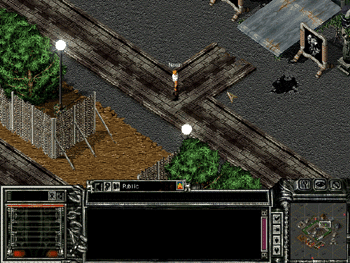
- Surroundings
The Action Window shows a detailed view of a small area of the province where your hero is. To the bottom right is the Mini-map, which shows the entire province. Small dots represent other players and computer controlled persons. The green dot represents yourself, yellow dots represent allies, and red dots represent neutral or enemy persons. Lightly-colored glowing squares represent shops or other places of interest. Green glowing squares are portals to friendly areas. Red glowing squares are portals to hostile areas. A white box shows the region seen in the Active Window.
Left-click on the Mini-map to center the Action Window on a location. Press<SPACE> to center the Action Window on your hero again.
- Movement
You can move your hero by using either the Active Window or the Mini-map. Clicking on the Active Window moves your hero to that location. If your hero is near a building, left or right-clicking on it in the Active Window will direct your hero to enter that building.
Right-click on the Mini-map to move your hero to that location. Note that because you may have clicked on an obstacle, your hero may not be able to reach the exact destination you selected.
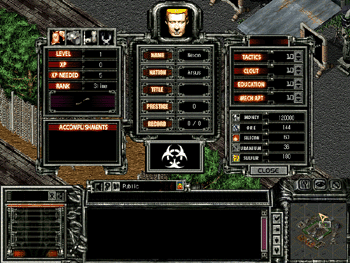 B.
Introspection
B.
Introspection
Click on your hero or press F4 to view your hero's current status. The Introspection Window is divided into five regions: Division standings, reputation, political standing, attribute, and resources. Each is described below.
- Division Standings
The top left region shows your characters' rank in the four divisions of warfare. The symbols at the top represent these four divisions: (from left to right) Infantry, Mobile, Aviation, and Specialist. Click on the appropriate symbol to view your hero's standing for that division.
The information shown is:
a) Level: A numeric representation of your hero's capabilities in this division.
b) Rank: Your hero's official title in that division. An alphabetic representation of rank. Rank increases roughly every three levels.
c) Unit: The sum of the levels of the units owned by your hero that belong to this division. Units are discussed in more detail in Section IV.
d) XP: Your hero's current experience points in this division. Heroes earn experience points when their units gain levels. Experience points are discussed in more detail in Section V.D.1.
e) XP Needed: The number of experience points required before your hero's level increases in this division. When XP = XP Needed, your hero's level will increase by one. When a hero's level increases, he may have access to better chassis types and will also gain a point to assign to one of his four attributes.
- Reputation
Your hero's exploits are recorded and summarized in the reputation region, which is located below the division standings. - Political Standing
While your division standings reveal your hero's advancement, such statistics are often irrelevant in political realms. Other heroes will judge your success and competence as a commander based upon your reputation and political status. Your political and reputation information is shown in the center region of the Introspection window, below your character's portrait.
a) Name: Your hero's name as chosen during hero creation. Note that your hero's name cannot be altered.
b) Faction: The faction to whom your hero pledges loyalty. You are automatically allied with other members of your faction or members of other factions with whom your faction is allied. Allies are discussed further in section V. Factions are discussed in more detail in section VI. Your faction's flag is displayed below the political standing region.
c) Title: Your hero's official title, if any, in his faction. With titles come administrative powers. Titles are discussed in more detail in Section VIII.
d) Prestige: A numeric representation of your hero's success in battle against other players (not aliens). After a victory against another player, your prestige will increase. After a loss against another player, your prestige will decrease. The magnitude of the change depends upon your prestige compared to your opponent(s).
e) Record: Your hero's wins and losses for all battles (battles against aliens included).
f) Honor: Every 100 points of honor provides a 1% health bonus to all of your units. Honor is gained by fighting in player versus player battles for your faction and is lost when fighting aliens. Mercenaries only gain honor when fighting for the weaker side. Abandoning your faction or joining a new faction will reset your Honor to 0.
g) Accomplishments: Special accomplishments of your hero are recorded in this region, located below your hero's division standings.
- Attributes
The top right section displays your hero's attributes. Your hero's attributes affect many aspects of gameplay. For every level your hero achieves in any division, he receives one point to assign to his attributes. Any available attribute points are shown in the area above the attributes. Use the arrow keys to assign these points as you deem best.
a) Tactics: Your hero's grasp on the intricacies of tactical combat. A hero's tactics determines how many units he can control during combat. Additionally, the hero with the highest tactics in any given battle is the field commander for his side (see Section V for more information).
b) Education: The quality of your hero's formal education, specifically in chemistry, physics, and electronics. Higher education allows your hero to install more advanced weapons, power supplies, sensors, etc. in his units (see Section VI).
c) Clout: The quality of your hero's political connections. Clout increases tribute from provinces owned by your faction as well as spoils obtained after conquering a province. Additionally, heroes with higher clout gain earlier access to more advanced chassis types (see Section IV).
d) Mechanical Aptitude: Your hero's ability to install, jury-rig, and maintain mechanical systems, specifically his units. High mechanical aptitude lessens weight restrictions when designing units, effectively allowing more potent designs to be created. Mechanical aptitude also has a small effect on what technology he can employ (see Section VI).
- Resources
Without wealth, reputation and rank are meaningless. Resources are required to repair, buy, and enhance units. Each resource represents a different aspect of unit/item research and design. With the exception of money, resource prices are dynamic and based upon a faction's supply and demand of the resource in question. For game play purposes, Shattered Galaxy resources are limited to five:
a) Money: While many factions create their own currency, money is represented in the ubiquitous Galactic Credit for simplicity's sake. Unlike other resources, money must be earned, not found. Because of its versatility and constant value, factional governments often reward heroes with money.
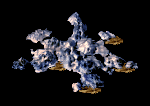 b)
Ore: Ore represents metals of all varieties. A large amount of ore is
required to generate even small quantities of rare metals, such as platinum
or titanium. Conversely, metals such as iron and copper are much more
common. All items require some quantity of ore. Fortunately, it is quite
common.
b)
Ore: Ore represents metals of all varieties. A large amount of ore is
required to generate even small quantities of rare metals, such as platinum
or titanium. Conversely, metals such as iron and copper are much more
common. All items require some quantity of ore. Fortunately, it is quite
common.
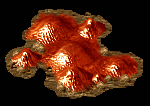 c)
Silicon: Complicated circuitry requires silicon. Sophisticated AIs,
as are present in some equipment, have especially high silicon requirements.
Silicon is also a priority resource for energy management systems.
c)
Silicon: Complicated circuitry requires silicon. Sophisticated AIs,
as are present in some equipment, have especially high silicon requirements.
Silicon is also a priority resource for energy management systems.
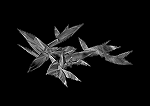 d)
Uranium: Radioactive uranium, available in the form of uranite, represents
energy and power. It is required in the construction and charging of
all power supplies. Uranium is the rarest and often the most valuable
resource.
d)
Uranium: Radioactive uranium, available in the form of uranite, represents
energy and power. It is required in the construction and charging of
all power supplies. Uranium is the rarest and often the most valuable
resource.
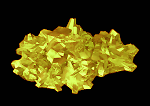 e)
Sulfur: Sulfur, a primary component in primitive gunpowder, is essential
for weapons and targeting systems. Sulfur is the most plentiful and
thus (generally) the least valuable resource.
e)
Sulfur: Sulfur, a primary component in primitive gunpowder, is essential
for weapons and targeting systems. Sulfur is the most plentiful and
thus (generally) the least valuable resource.
C. Communication
Shattered Galaxy includes a sophisticated communication interface to allow players to easily interact with each other. Communication tools include real-time communication, an in-game bulletin board system, and hero lists.
- Real-time Communication
The center bottom portion of the screen contains three sections: the Message Recipient Window, the Message Window, and the Chatting Log. The Chatting Log contains the messages your hero either receives or sends. Additionally, informational messages from the server may appear in this region. A scroll bar allows you to view older chatting messages.
Whenever you type, the text will appear in the Message Window. Pressingsends that message to the recipient designated in the Message Recipient Window. Clicking on the Recipient Window allows you to change the recipient.
Possible recipients are:
a) Public: Those around you will receive this message. (Shortcut: ')
b) Private: Only the person indicated to the right of "Private" will receive this message. (Shortcut: ")
c) Allied: Only members of your faction around you will receive this message. (Shortcut: /)
d) Group: Only those selected in the Recipient List will receive this message (see below).
To the left of the Chatting Log is the Recipient List. The Recipient List allows you to easily communicate with many players either simultaneously or individually.
Add names to this list by clicking on the text box at the top of the Recipient List and typing the name of the hero you wish to add. You will see their name added to the recipient list. Click on a name in the Recipient List and the Message Recipient Window will automatically change to "Private", with the recipient being the person you selected. Heroes can also be added to the recipient list by left-clicking on the hero's name in the chatting window or on the who lists (see Section III.C.4).
Use<ctrl>-click to select multiple names simultaneously. Doing so will change the recipient in the Message Recipient Window to "Group". When the recipient is set to "Group", any message you send will be automatically sent to all names selected in the Recipient List. Public and Allied communication functions normally regardless whether names are selected in the Recipient List. Public and Allied communication functions normally regardless whether names are selected in the Recipient List. Next to the text box above the recipient list are two buttons to toggle between the Recipient List and the Ignore List. You will not receive communications from anyone you place on your Ignore List.
You can also send private messages to heroes by either clicking on their name on the Hero List or clicking on their private message to you in the chatting window.
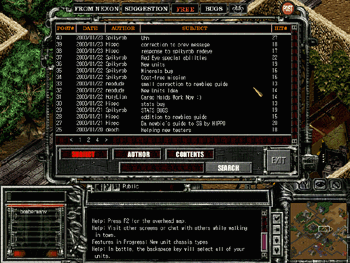 Bulletin Board System
Bulletin Board System
A bulletin board system is provided for Shattered Galaxy players to discuss aspects of the game and to receive information from KRU Interactive. Four public and one private bulletin boards are provided:
a) From KRU Interactive: Announcements from KRU Interactive. Players cannot post to this board.
b) Suggestions: For players to post their suggestions about the game. Debate and discussion among players is encouraged, but please try not to be argumentative.
c) Free: For in-game discussions on any topic the players wish. Please be civil.
d) Bugs: For players to post about bugs they discover. Please check http://www.sgalaxy.com/bug-pop.html for known bugs before posting. Information on fixed bugs will also be placed on this board.
e) Faction: Each faction has its own bulletin board which only its members can post to and read. [Not fully implemented]
The bulletin board system is accessed through the thumbtack icon, which is located to the right of the Chatting Log. Click on a post's subject to read that post. "Hit #" displays the number of times a particular post has been read. Posts can be searched by subject or author through the search command located at the bottom of the bulletin board window. You may modify or delete posts you previously made by using the appropriate buttons.
- Shattered Galaxy Mail
A personal mailbox is available to each hero. Click on the mail button, in the top right corner of the Chatting Window, to access your hero's mail and to send SGMail to other heroes. - Who Lists
The Hero Lists can be viewed by pressing F6 or by clicking on the magnifying glass button, which is located above the mini-map. Tabs at the bottom of the User List allow you to switch views between the four available lists: User List, Regiment List, Faction List, and the Hero Hall of Fame. Clicking on a column header for any list will sort the list by that column.
The User List displays information about all heroes currently logged in. Left-clicking on the Level column toggles the column between Level and Rank. Left-clicking on the Record column toggles between a win/loss format and a win percentage format. The Regiment list shows all regiments, their faction, commander, and history. Left-clicking on a regiment name adds it to your recipient list. Double-clicking on a regiment in your faction allows you to leave/join that regiment. Overlords and Council Members, who cannot leave or join regiments, can open/close regiments to new members by double-clicking on them. Regiments are discussed in more detail in section V.
The Faction List contains information on all factions with provinces located on the same planet as your hero. Faction territories, heroes online, and total tribute holdings are all displayed.
The Hall of Fame shows the most powerful heroes in the game, whether or not they are logged on.
D. Points of Interest
Hero Mode is also used to travel between areas and
conduct business at various shops in town. Points of interest are briefly
explained below.
- Unit Assembly Factory (Factory)
Heroes use the factory to buy pre-designed units, repair damaged units, and sell unwanted units. Pre-designed units are competently equipped and battle-ready.
- Unit Development Facility (Lab)

The lab is used for the design of new units or for upgrading units the hero already has. Options available at the lab are discussed in more detail in Section VI.

- Resource Exchange Market (REM)
The REM allows heroes to buy or sell resources (ore, silicon, uranium, sulfur). All transactions in the REM are taxed by the factional government. Prices are dynamic and depend upon the availability of that resource in the faction. A REM will never run out of a resource, but resource prices will increase as long as demand exceeds the faction's supply.
- Simulation Center (Sim)

The sims allow heroes anywhere in the galaxy to combat each other with no risk to their units. The sim is primarily used to test new designs or to combat with distant friends. Simulated combat is discussed in more detail in Section V.
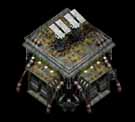
- Combat Training Facility (CTF)
This specialized simulation center allows heroes to practice solo-fighting against aliens. Unlike in the Sim, the heroes own units are not used in a CTF battle. Instead premade units of a variety of types are provided. The CTF is an ideal place for a novice hero to learn.
- Royal Rumble

The Royal Rumble combat simulator hosts king-of-the-hill style combat between multiple heroes. There is a substantial entry fee as well as an award for the victor.

- Faction Headquarters (FHQ)
While any competent leader is more likely on the battlefield than in an office, FHQ is the political heart of the Faction. Political information and voting terminals can be found within. The Shattered Galaxy political system is discussed in more detail in Section VIII. [not fully implemented]
- Portals

Portals provide quick access between provinces. Entering a portal that leads to hostile territory will cause a pre-combat screen to appear. In general, portals move a hero is the expected direction. For example, entering a portal in the south- west corner of a province moves your hero to the province to the south-west of where he began. On the mini-map, portals to allied provinces are shown in green, portals to hostile territory in red.(see also the description of the Strategic Map in Section V.C.3)
- Subterranean Caverns

These ominous portals lead to underground regions from which the ubiquitous aliens pour onto the surface realm. Because of the toxic (to humans and machinery) atmosphere underground, these areas cannot be conquered. Heroes of all skill levels often use the subterranean realms as training grounds. - Artificial Subterranean Cavern (Zoo)
The Zoo is a faction-constructed cavern used as a training ground for new heroes. Unlike the subterranean caverns, battles in the Zoo are always fought alone. Only very weak aliens can be found here, as the more powerful ones are too dangerous to keep in captivity. - Observatory

The Observatory provides information on the current positioning of the planets as well as detailed information about each planet. Heroes should visit the Observatory before planning an interplanetary journey. - Dimensional Matrix
Dimensional matrices allow heroes to transport between the Space Stations on each planet. The Dimensional Matrix also provides the various information available in the Observatory. Dimensional matrices can only be found in the Space Stations orbiting each planet. - Mercenary Guild
The Mercenary Guild, located only in the Space Stations, allows heroes to leave their current faction and join or found new factions. Heroes leaving Morgana Prime to explore the remainder of the Morgana star system must first visit the Mercenary Guild on the Morgana Prime Space Station to abandon their faction. - Star Portals
Star portals are located in faction capitals on Morgana Prime and in the center province of every planet. Star Portals allow heroes to travel to the Space Station orbiting their planet. The Space Stations each contain a Unit Assembly Factory, a Dimensional Matrix, and a Mercenary Guild.